A pair of wild ducks have been visiting from early March, the drake does not eat but protectively keeps guard over the female and watches her, my hopes were up that she was nesting in our garden. He seemed to love her, despite her manners.
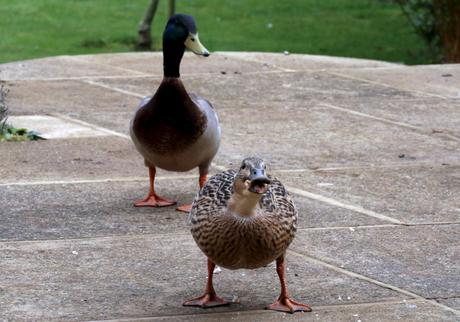
Protective Drake watching his mate
A few days later, my neighbours with a large pond told me the duck had laid eggs in their garden, under an elderly Sage bush, I have been given visitation rights but felt a little disappointed as I had wanted the chicks to be born here.
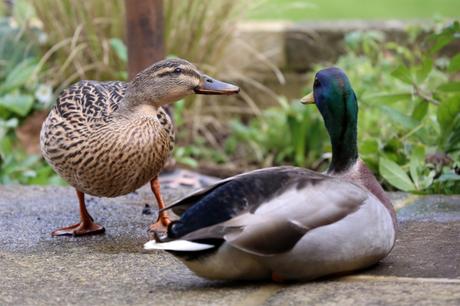
The pair continued to visit and the Drake still did not eat, he cannot feed her in the way other male and female birds do, but he can lead her to a source of food. She lays more than half her body weight in eggs, so needs plenty of rest and nutrition. This last week, he has started to eat too, his job is done for this Spring and will be off, their love was brief, they do not pair for life and then if no replacement clutch is needed he joins other groups of males for the summer moult. There is a short period between siring one clutch and the summer moult when groups of males behave in a foul manner towards females, I hope she is spared.
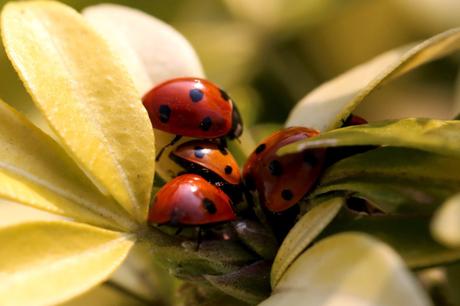
7 spot native Ladybirds (Coccinella 7-punctata)
During the late March tidy up I was delighted to see lots of 7 spot native Ladybirds emerging from dormancy and searching for handy mates. During their year long lives, they can eat 5,000 aphids each, even the larvae eat aphids. The parents die as the new generation emerge and the cycle continues.
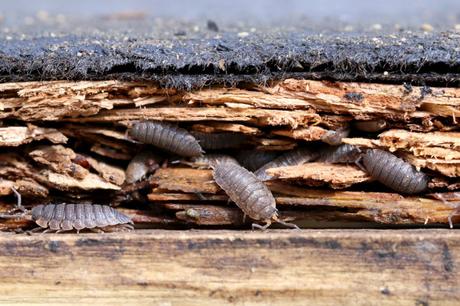
Woodlice, possibly Porcellio scaber
Elsewhere, the children’s Wildlife Centre has been taken down. They have left home and I wanted to let more light into the potting shed, the center was a lean-to tacked onto the side, blocking some of the windows. The wood was rotten with only fond memories holding it up and still home to the inspected and usually nocturnal woodlice. Predated by Toads, woodlice are one of natures recyclers eating rotting vegetation. In its place we now have another small log store with living roof, placed under the shed windows, although we do not need insulation for the wood store, I wanted another growing space for pollinators, hence the living roof. The soil is 3-4″ deep, the spot sunny and sheltered. I’m still dithering over plant choices but to start will experiment with some shallow rooted Phacelia tanacetifolia.
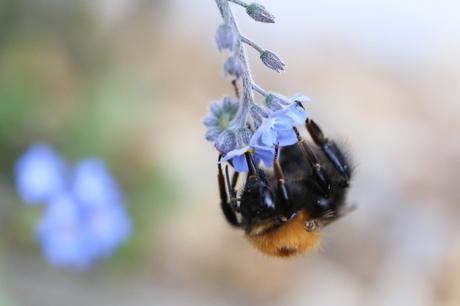
Tree Bumblebee (Bombus hypnorum) on Forget-me-not (Myosotis sylvatica)
Bees have been foraging too, climate change has enabled the European Tree Bumblebee to make its home in the UK and this worker feeding on self seeded Forget-me-nots had mites and was trying to clean them off by combing its legs over the body, I’ve read on the Bumblebee Conservation Trust website that some mites are not harmful, but if a heavy infestation, when the weight of the mites would inhibit flight a small childs paintbrush can be used to gently brush them off.
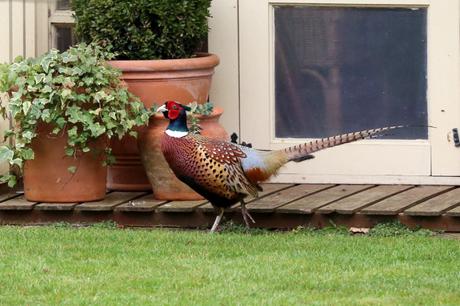
Male Pheasant
Amongst the usual bird visitors, a male Pheasant has appeared on a daily basis, they were introduced into the UK for gun sport. Its estimated 40 million Pheasants and 10 million Partridges are raised in battery cages for release during the “season”. Animal Aid’s report on the welfare of these birds make gruelling reading. Animal aid are campaigning for a ban on the use of these cages. Its quite staggering that the shooting lobby claim these shoots are good for our countryside.
In more uplifting news, our Robins have nested and begun to lay eggs but alongside my potting tray behind several stacks of waiting pots, I cannot risk upsetting her, incase she abandons her eggs, I have read she will lay one egg a day usually early morning and a normal clutch is 4-6. They are used to me in and out of the shed but think it will be a step too far to prick out seedlings so close to her. It will be 13 days for her to incubate the eggs, 14 days further for the chicks to fledge and then both adults continue to feed them for a further 3 weeks. So all in all I will be potting on seedlings in the summerhouse this year and hoping to see the chicks in a few weeks time.
My grateful thanks to the lovely Tina for hosting the Wildlife Wednesday meme, please take a look at other wonderful wildlife across the globe.
Happy Wildlife Watching!
